Haswell Z87 Motherboard Preview: 50+ Motherboards from ASUS, Gigabyte, ASRock, MSI, ECS, Biostar and EVGA
by Ian Cutress on May 22, 2013 5:00 PM ESTMSI Z87
MSI have kept their cards relatively close to their chest on this one, except for one microsite detailing the core of their gaming and overclocking range. So far we have details on:
MSI Z87-GD65 Gaming
MSI Z87 MPower
MSI Z87 MPower Max
MSI Z87 XPower
It seems that the Big Bang moniker is finally gone, with MPower being the mid-range overclocking motherboard and the XPower being used for those sub-zero extremists.
MSI Z87A-GD65 Gaming
It was not too long ago that we had a look at the Z77A-GD65 Gaming, whereby MSI described to us that the Gaming range was initially intended for Haswell launch, but due to the extra delay added on by Intel they decided to forge ahead with a Z77 model. Back with that model, there was various limitations on what they could do (either physical or temporal), but Z87 has brought some of them out. Looking at the board we see larger heatsinks for the VRM and the Dragon, as well as Audio Boost:
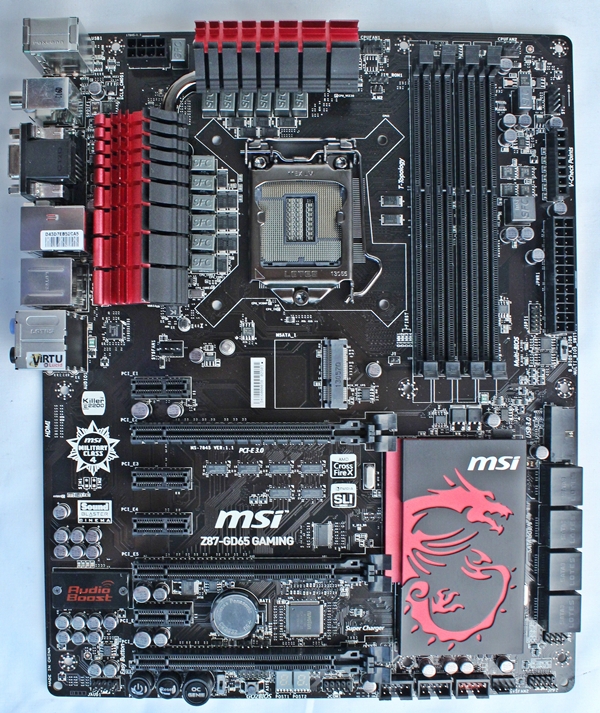
I was initially fooled by the lines on the board with the mSATA, thinking it was something special, but the fastener for the screw means that it is only an mSATA port. The big thing on the left hand side of the board is obviously Audio Boost, which given the motherboards already seen in this preview I would hazard a guess at an ALC1150 hiding under an EMI shield. The microsite states support for 600 ohm headphones as well.
On the board itself we see MSI voltage checkpoints, eight SATA 6 Gbps (it seems all are coming from the chipset?!), the classic OC Genie, also Go2BIOS for Windows 8 users/overclockers. Multi-BIOS also makes an appearance, selectable by a BIOS switch.
MSI Z87 MPower / MPower Max
Source: 59hardware, PC Authority
MSI seems to be splitting their overclocking motherboards into two groups – MPower for the lower cost 24/7 overclocking, and XPower for extreme overclock users. For the MPower, two versions are being released – a normal version and a MAX version. These two boards look very similar, and without close inspection we might miss the differences between them.
The MPower Max:
The MPower:
The differences I can fathom are a slightly rearranged audio layout, moving the two-digit debug from the corner to below the 24-pin ATX connector, the fan headers being slightly rearranged and the OC Genie button moved. Nevertheless on both boards we get Audio Boost, voltage check points, eight SATA ports, what looks like an x8/x4/x4 PCIe layout, an mSATA in the idle of the board, a ClearCMOS button at the back and what looks like space for an extra card on the rear IO. In fact some of the images on the MSI Microsite suggest that this is an 802.11n card – this means the Max might have the card and the normal MPower may not as a price point differentiator.
MSI Z87 XPower
MSI have kept the Z87 XPower very close to their chest. The only images we have are mild corner or socket focused images, but nonetheless it offers potential. At least we can see a big yellow X on there:
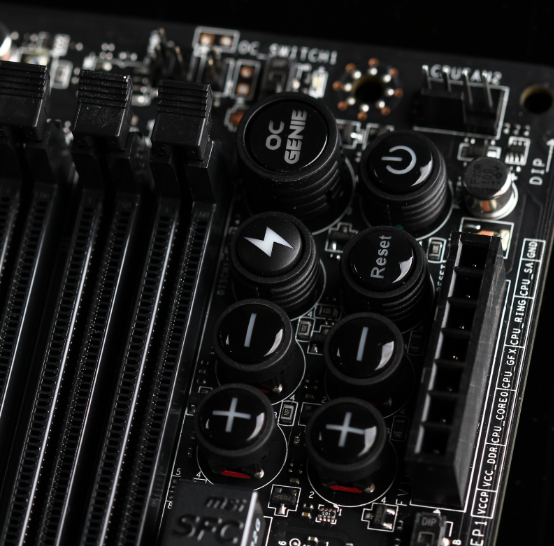
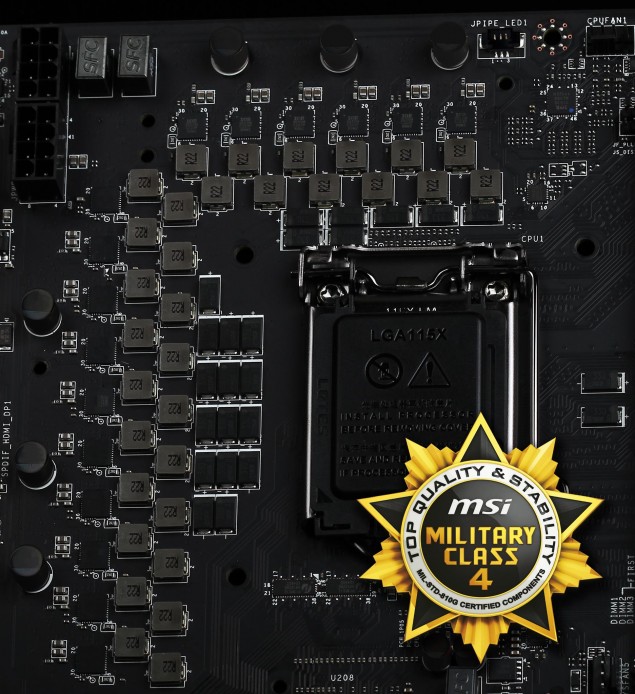
Source: WCCFTech
Biostar Z87
Source: GamersNexus, Hardware.info
During our time on Z87, Biostar never really jumped into the picture. There were murmurings of their Puro audio solution, using pairs of large caps to help filter out analog signals. When it comes to the new Haswell generation, we got wind of several boards coming to market:
Biostar Hi-Fi B85S3 (mATX)
Biostar Hi-Fi H87S3+ (mATX)
Biostar Hi-Fi Z87W
Biostar Hi-Fi Z87X 3D
Gone are the years of orange Biostar boards – whereas everyone seems to be moving away from blue, Biostar are bringing it back with their higher end range.
Biostar Hi-Fi B85S3
First up is a B85 board in a micro-ATX form factor:
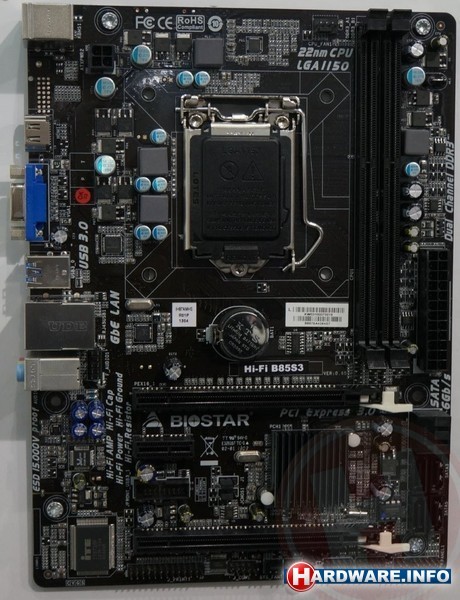
While Biostar are keen to announce the use of USB 3.0, the LGA1150 socket, PCIe 3.0, SATA ports and DDR3, the text relating the audio interests me more. Here we have ‘Hi-Fi AMP’, ‘Hi-Fi Cap’, ‘Hi-Fi Power’, ‘Hi-Fi Ground’ and ‘Hi-Fi Receiver’, which could mean we have a half decent audio solution on a cheap end board, but I would not hold my breath – judging by the three audio outputs we probably have an ALC889 onboard.
The PCIe layout suggests an x16/x1/x1/x4 layout due to the B85 chipset, and the SATA ports have two upright and four coming out of the board. The Rear IO looks a little bare but we clearly have a HDMI, VGA, and a few USB 3.0 ports.
Biostar Hi-Fi H87S3+
Moving up the chain to H87 we have a similar looking board to examine, especially in terms of IO.
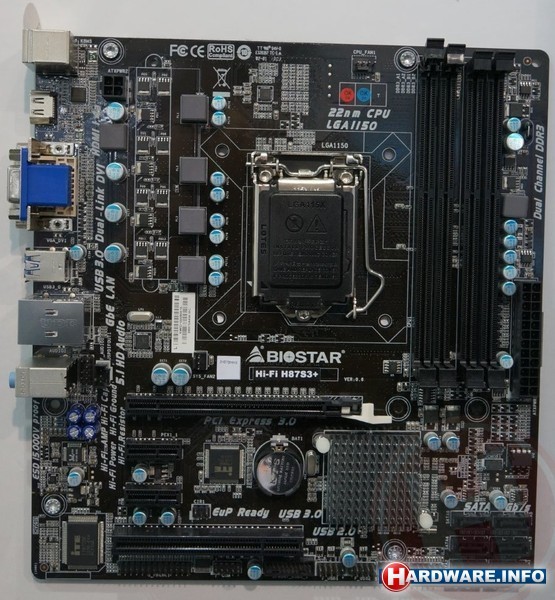
The PCIe lane allocation is sporting a PCI connector at the bottom, and the SATA ports (there seems to be six under the logo) are all coming out of the board. The audio solution still looks like an ALC889 however. On the IO the VGA looks like it is now above a DVI connector.
Biostar Hi-Fi Z87W
The full ATX models from Biostar are starting to actually look nice, rather than the orange of yesteryear. The Z87W comes in focused all within the Puro Hi-Fi:

So Puro was on Z77 but unfortunately we did not have a deep look at it. With Z87 I do hope they are using the ALC1150 as well as supporting 600 ohm headphones, though without technical specifications I can only speculate. Biostar have never been one for multi-GPU setups, but we get what looks like an x8/x8 allocation on the GPUs, as well as power/reset buttons and a two-digit debug LED.
Biostar Hi-Fi Z87X 3D
Another step up the ladder and we get a clear shot of the next motherboard up the range, the Z87X 3D.
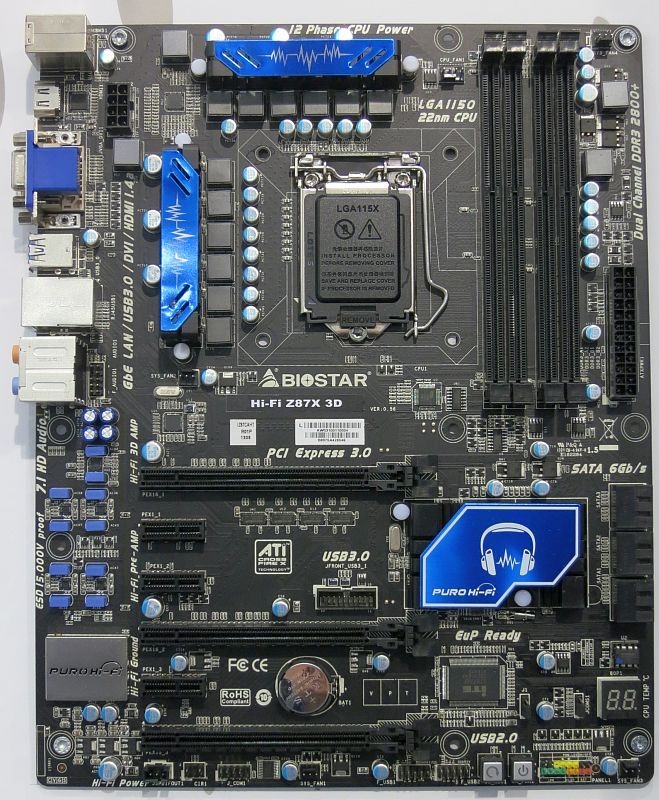
We can see Biostar are slowly upping the number of phases for the CPU (it states on the top of the board 12), and the Puro Hi-Fi takes up a good portion of the left hand side of the board. PCIe allocation looks like an x8/x4/x4 (or x8/x8 + x4), and we get proper power/reset buttons this time around. It is worth noting the very strange location of the USB 3.0 connector – right in the middle of the motherboard. This means a cable stretched across the board, and no luck if you decide to use a triple slot GPU or large PCIe x1 card.
EVGA Z87
With most of the recent releases, EVGA has not been a big player on release day, typically only releasing one or two products with up to three or four motherboards per chipset in total - for example on Z77 we had the FTW and the Stinger. I was lucky enough to catch one of Jacob Freeman’s tweets today showing off their Z87 motherboard:
It looks like we have a new BIOS, that the EVGA board is, as always, looking substantial in terms of heatsinks and PCIe. EVGA employ K¦ngp¦n, one of the world’s top overclockers, who constantly uses EVGA boards to break overclocking world records when he can. Of course I would like to see what EVGA have up their sleeve for this generation.


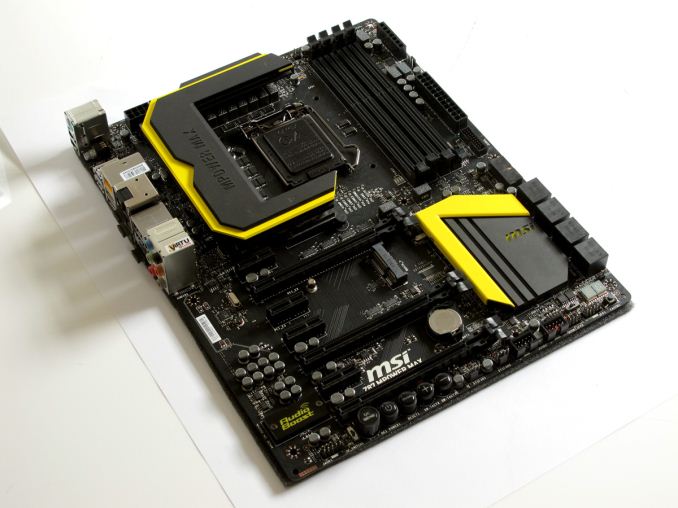
_575px.jpg)







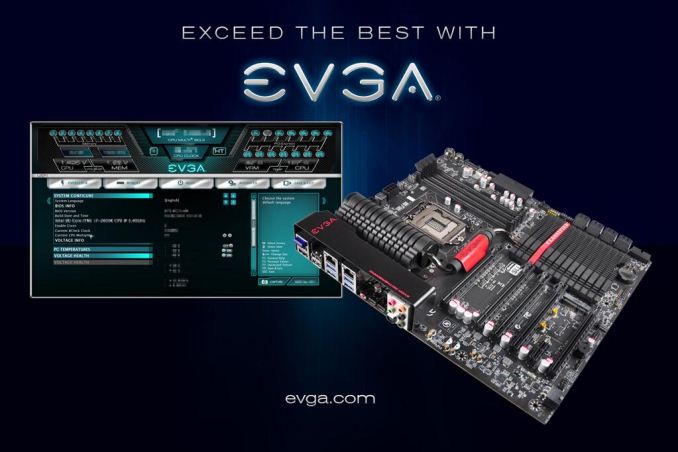








70 Comments
View All Comments
vailr - Wednesday, May 22, 2013 - link
What about DDR4? Will Intel offer a revised chipset (Z88?) for DDR4 + Haswell CPU's later this year?sticks435 - Wednesday, May 22, 2013 - link
No, DDR4 will most likely debut on the new Enthusiast boards (X79 or X89 or X99). It will be either 2014 or 15 before we see it on mainstream boards.Death666Angel - Wednesday, May 22, 2013 - link
Haswell doesn't seem to support DDR4. The memory support is based on the CPU since a few generations back, not the motherboard/chipset anymore. Haswell-E might support DDR4 by the looks of it.Sm0kes - Wednesday, May 22, 2013 - link
Really interested to see if Thunderbolt can make any meaningful advances..... if not this year, i suspect this will be dead technology. Was really looking forward to seeing eGPU's become a reality.xTRICKYxx - Wednesday, May 22, 2013 - link
Thunderbolt only has a PCI x4 access so a AMD Radeon HD 6670 is going to fully saturate it....I want to believe Intel will fix this so eGPU's can succeed!
Jaybus - Thursday, May 23, 2013 - link
Haswell uses the same x4 configuration, but with PCIe 3.0 and a bandwidth of 20 Gbps. Since that matches the current max Thunderbolt spec, why would they use more than 4 lanes? There simply isn't a lot of headroom for going > 20 Gbps over copper without limiting the cable length to only a few cm..They are working on silicon photonics to integrate a chip level optical interconnect to make optical Thunderbolt cheap enough, but until then there just isn't much need for more than 4 PCIe 3.0 lanes.bobbozzo - Wednesday, May 22, 2013 - link
on P1, "Within that is the cost for the chipset (a not-significant cost)"Do you mean not-INsignificant?
thanks for the article!
Death666Angel - Wednesday, May 22, 2013 - link
Well, any of the mATX motherboards look good. My preferred brand is Gigabyte for the good value and performance. Asus usually when I have the money laying around and want a feature or two they offer. AsRock is also good if they are competitive with Gigabyte by being cheaper or offering more for the same money. The other manufacturers I have little experience or dodgy experience with. :DI would like a mATX with good overclocking, Intel NICs, decent onboard sound, 8 SATA connectors and maybe mSATA. I don't need wifi, more than 8 SATA, more than 2 USB 3.0, LCDs, reset/power buttons onboard, SLI/CF support or anything fancy like that.
Egg - Wednesday, May 22, 2013 - link
Am I misinterpreting something, or do post of the lower end boards include PCI? I thought some of them would drop it, as people with the expansion cards that need it often will look for better boards, and it now needs an extra controller.meacupla - Wednesday, May 22, 2013 - link
They fill in the gap between the business (B series) and enthusiast (Z series) chipset.